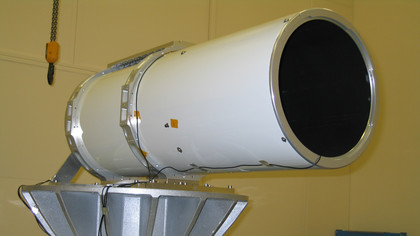Revealed: the streaming space cameras that'll point at your house
Cameras to be installed on the ISS
The website will enable you to plot the ISS's orbit, so if you wanted to, you could actually watch video taken just after the ISS passes over your location.

The Medium Resolution Camera's (MRC) perspective is approximately 150km wide and 50km high, and you will see the image scrolling past.
With the help of image processing, you will be able to view from different angles, either straight down, or from about 45 degrees angle, in the flight direction of the ISS. The Camera will be constantly recording everything that passes below, day or night, which will give a very unique perspective that few people will have seen before, such as seeing the lights of cities passing below.
Areas under the spotlight
In addition to the MRC's "streaming feed" UrtheCast will be gathering images from the High Resolution Camera (HRC) of selected spots around the world, covering an area of 5km x 3.3km. These videos could include such events as the Japanese Tsunami, for instance and will be available as individual, searchable videos on the website.
The HRC can move on two axis, known as the Bi-Axial Pointing Platform (BPP) and can record an area for up to two minutes, before the ISS moves out of range, although most videos will typically be around one minute long.
The BPP is controlled by computers on the ISS Russian Segment (ISS-RS) and they use knowledge of the ISS position and the ISS orientation provided by star trackers, which are mounted near the cameras, to work out in real time the BPP pointing angles and angular rates needed to track a given point on the ground. In this way the HRC can quickly be repositioned to cover a particular area on the ground track.

Footage will be downloaded to a ground station in view, every 90 minutes or so, using a 100mbps downlink and there will probably be ten stations in all, with several of them likely to be in Russia.
Sign up for breaking news, reviews, opinion, top tech deals, and more.
Received images will then need to be processed before they are viewable on the web, which is why there is a 2-3 hour delay, but it still means that we will be able to see images much faster than many conventional means.
While we won't quite be entering the realm of Jack Bauer, UrtheCast is a world beyond what we're used to with Google Earth.
The website will plot the ISS's track, so if you have an outside event planned and you know the ISS will be overhead, you can watch the view from the sky a few hours later. And though it's impossible to know how well the system will work and how good the images will be, until the cameras are actually live, if Urthcast can deliver half of what it promises, it will revolutionise the way we view the planet.
The cameras have been built by a British company and promise a resolution of 1 metre